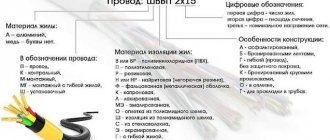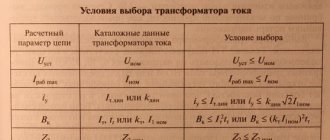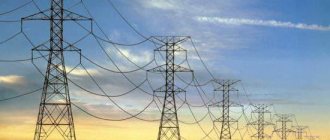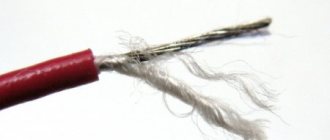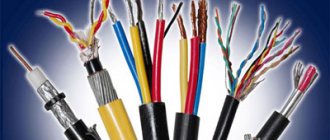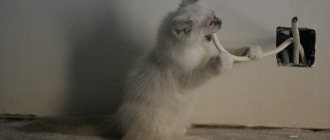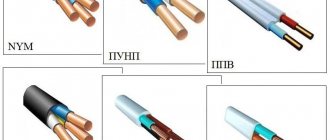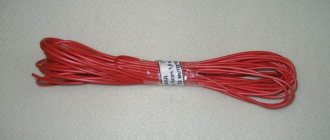To connect new household equipment or make high-quality extension cords (surge protectors), ShVVP wire is most often used. Cords are made from it for most types and models of household appliances.
At more powerful production facilities, for powering consumers in high-voltage electrical networks, preference is given to other analogues. Only in rare cases can it be used to arrange a temporary power line.
Decoding
If we consider in detail the meaning of the abbreviation SHVVP, it will become clear that this is not a wire or a cable, but a cord. A cord is an electrical product designed to connect consumers to an alternating current network and having several (at least two) cores. The current-carrying conductors are mainly elastic and have a cross-section of up to 0.75 mm2.
Attention! If the housing of the connected household appliance does not require a grounding conductor, then the cord has two conductive wires. According to GOST 7399 - 97, this is a household cord. In other cases, the cords are multi-core products.
Three-core ball screw
The marking is an inscription that combines letters and numbers. It is applied to the surface of the conductor every meter. The decryption has the following meaning:
- Ш – cord;
- B – polyvinyl chloride (PVC) sheath of current-carrying conductors;
- B – polyvinyl chloride (PVC) outer shell;
- P – flat.
Double insulation makes the cord safer with respect to electrical effects on humans. In addition, PVC materials are not subject to active combustion.
Design
The structure of a flat flexible wire is clear from Fig. 1.
Rice. 1. ShVVP cord design
Structurally, the flexible wire consists of copper conductors covered with polyvinyl chloride sheaths. They are located parallel in one plane, covered with individual multi-colored insulation. The flat profile of the cord is given by the shape of the outer shell, consisting of the same polyvinyl chloride, but with other additives.
ShVVP products use stranded copper conductors. The wires in the bundles are twisted to the left to enhance the strength of the core shape. This can be clearly seen in Figure 2.
Rice. 2. Type of copper conductors of the SHVVP wire
Please note: flat wires come in two-core and three-core types. Their PVC insulation has properties that are ideal for patch cords:
- significant resistivity;
- withstands short-term high temperatures generated by insulated conductors in critical situations. Rated operating temperature can reach 70ºC;
- the material of the insulating layer ensures high flexibility of the wire (limit – up to 30,000 bends);
- has a fairly long service life;
- polyvinyl chloride is environmentally safe;
Some parameters and properties of the outer sheath are slightly different from the qualities of the insulating materials that protect the inner cores. More plasticizers and stabilizers are added to their composition, providing aesthetic appeal, resistance to sunlight, and better mechanical strength. These qualities are important for cords used in connecting household appliances and in the manufacture of extension cords.
ShVVP cord design
The decoding of the abbreviation almost completely describes the structure of the cord. However, there are several more design characteristics:
- core design;
- number of current-carrying components;
- location of current leads;
- coloring.
SIP cable 2: technical characteristics
The cord cores are made of copper. They have a round cross-section (0.5 or 0.75 mm2) and consist of many wires. This is done to increase the flexibility of the product.
For your information. GOST implies the presence of 7 wires with a cross-section of 0.35 and 0.38 mm2, for ShVVP 2*0.5 and ShVVP 2*0.75, respectively.
The number of cores in an electrical product is two or three. The conductors are located under the outer insulation parallel to each other. The thickness of the outer PVC sheath must be more than 0.6 mm, and the thickness of the core insulation must be more than 0.5 mm.
Color coding identifies the following conductors:
- zero – blue insulation;
- phase – brown insulation;
- the grounding conductor is yellow-green (if present).
Important! If the plug has special contacts, and the socket allows its connection to the grounding bus, then the use of a grounding conductor of the cord is mandatory.
Cord structure
Table 6
| Brand | Number of insulated cores | Nominal cross-section of cores, mm2 | Nominal tensile force, N (kgf) | Nominal diameter of rollers, mm |
| Ball screw, Shvd | 1 or 2 | For all sections | 9,8 (1,0) | 60 |
| ShVVP, ShVL, ShRO | 2 or 3 | For all sections | 9,8 (1,0) | 80 |
| PVS, PVSP | From 2 to 5 | 0,75; 1,00 | 9,8 (1,0) | 80 |
| 1,5; 2,5 | 14,7 (1,5) | 120 | ||
| PRS, PSG, PRM | From 2 to 5 | 0,75 | 9,8 (1,0) | 80 |
| 2 | 1,0; 1,5 | 9,8 (1,0) | 120 | |
| 2,5 | 14,7 (1,5) | |||
| 4,0 | 24,5 (2,5) | 160 | ||
| 3 | 1,0 | 9,8 (1,0) | 120 | |
| 1,5 | 14,7 (1,5) | |||
| 2,5 | 19,6 (2,0) | 160 | ||
| 4,0 | 29,4 (3,0) | |||
| 4 | 1,0; 1,5 | 14,7 (1,5) | 120 | |
| 2,5 | 24,5 (2,5) | 160 | ||
| 4,0 | 34,3 (3,5) | 200 | ||
| 5 | 1,0 | 14,7 (1,5) | 120 | |
| 1,5 | 24,5 (2,5) | 160 | ||
| 2,5 | 29,4 (3,0) | |||
| 4,0 | 39,2 (4,0) | 200 | ||
| SHOG | — | 4,9 (0,5) | 5 | |
Established trouble-free operating time, hours, not less than: 3000 - for cords of the ShVP, ShRO and ShVD brands; 5000 - for wires and cords of the ShVVP, ShVL, PVS, PVSP and PRS brands;
12000 - for wires and cords of the ShVVP, ShVL, PVS, PVSP brands used in stationary electrical appliances. Service life of wires and cords, years, not less: 4 - for ShRO brand cord;
10 — for cords of the SHOG, SHOG-S brands; ShVVP, ShVL, PVS, PVSP, used in stationary electrical appliances; 6 - for wires and cords of other brands.
Species diversity
KVVG cable
The manufacturer can change the color marking, both external and the color of the core insulation. The designation SHVVP does not indicate a specific color, so black cord is also found. The manufacturer has the right, based on GOST-7399-97, to change the color scheme. But this does not in any way affect the quality and price.
Carefully. When purchasing this product, in which the cross-section of the current-carrying conductor is indicated as 3; 4; 6 mm2, you need to remember that it does not comply with this GOST. This means that the product is not certified.
Specifications
Cable PUGNP
Shvvp wires have the following technical characteristics:
- mechanical - describing the device of the product and design parameters;
- electrophysical - telling about the electrical characteristics for a given type of cord, based on the physical properties of the materials.
When operating a conductor, both are of no small importance, so they are considered separately.
Mechanical
The main mechanical parameters include:
- flexibility;
- permissible number of bends and extensions;
- tensile strength;
- temperature stability.
The minimum Rbend (bending radius) for ball screws is equal to five cable diameters. The geometric feature of the cord is flat, so the smallest diameter is taken.
Minimum bend radius
The cord allows you to perform at least 30 thousand “flexion-extension” cycles during its operation.
By the way. The more similar cycles a product has experienced, the shorter its service life. Wires that are constantly exposed to such mechanical loads last no more than 2 years, with static use - 10 years.
In tensile tests, this product must withstand loads of up to 9.8 N, which is 1 kgf. Such a load should not cause external damage to the cord.
The temperature resistance of the conductor must be able to withstand exposure to high and low temperatures. When tested, a certified ball-and-ball screw can withstand the influence of T = +800C for 90 hours. Moreover, after the cord cools down, there are no signs of damage on it. Tests at low temperatures are performed by mechanical pressure (rolling through rollers) and impacts.
Limit standards for normal operation – from - 250С to +400С.
Attention! When operating a consumer connected using such a cord, the maximum permissible core temperature is +700C. If the temperature exceeds this value, it means that the cross-section of the conductors is selected incorrectly.
Electrophysical
Electrical characteristics for the wire are the reference criterion when choosing a product.
These parameters include the following items:
- conductor resistance;
- insulation resistance;
- permissible current load.
The resistance for the conductors under consideration with two reference sections of cores (0.5 and 0.75 mm2) is equal to 39 Ohm/km and 26 Ohm/km. This is true under the conditions that the diameter of the wire in the bundle is no more than 0.16 mm, and the direct current resistance was measured at a temperature of 200C.
GOST-7399-97 regulates the insulation resistance value of more than 0.012 Mohm/km for a copper section of 0.5 mm2 heated to 700C, and 0.01 Mohm/km for 0.75 mm2.
Information. Insulation resistance is measured between wires and between each wire and ground.
An acceptable load is considered to be one in which the current flowing for a long time through the conductor under load does not heat the conductors above the permissible (operating) temperature. For both sections, the permissible current is 2.5 and 6 A, respectively.
ShVVP wire supplies
The last criterion that you should pay attention to when choosing is the correct marking of the coils and the cable itself. This marking is applied in accordance with GOST 7399 - 97 and must necessarily contain the designation of this standard.
| Let's start with marking the wire. As you can see in the video, the wire must be marked with the manufacturer's trademark, wire size and year of manufacture. |
| In this case, inscriptions on the wire must be applied every 500 - 550 mm. Not applying inscriptions is allowed only if agreed with the consumer when using cords for reinforcement. |
| In this case, in any case, the coils must be provided with an appropriate label. It indicates the symbol of the cord, the length of the wire or the length of the pieces that make up the coil, the weight of the coil, the name of the manufacturer and the date of manufacture. |
| At the consumer's request, a technical control stamp can also be applied to the bay. If the wire is intended for retail sale, then all the above data must be indicated on the attached label. |
Where is it used?
The shvvp wire, the decoding of which speaks about its features, is used mainly for connecting to a 220 V AC network in everyday life. It is convenient to connect household electrical appliances (hair dryers, irons, refrigerators, TVs and much more) using a flexible conductor. Carrying cases and various extension cords are also made from a similar cord and are practical. It is not recommended to connect permanent electrical installations.
Wire Application Table
NORMATIVE REFERENCES
This standard uses references to the following standards:
GOST 20.57.406-81 Integrated quality control system. Products of electronic technology, quantum electronics and electrical engineering. Test methods
GOST 427-75 Metal measuring rulers. Specifications
GOST 2789-73 Surface roughness. Parameters and characteristics
GOST 2990-78 Cables, wires and skins. Voltage test methods
GOST 3345-76 Cables, wires and cords. Method for determining electrical insulation resistance
GOST 7229-76 Cables, wires and cords. Method for determining the electrical resistance of current-carrying cores and conductors
GOST 12176-89 Cables, wires and cords. Test methods for flame retardation
GOST 12177-79 Cables, wires and cords. Design verification methods
GOST 12182.1-80 Cables, wires and cords. Methods for testing resistance to repeated bending through a roller system
GOST 12182.8-80 Cables, wires and cords. Bending resistance test method
GOST 15150-69 Machines, instruments and other technical products. Versions for different climatic regions. Categories, operating, storage and transportation conditions regarding the impact of environmental climatic factors
GOST 16962.1-89 Electrical products. Test methods for resistance to climatic external influences
GOST 17491-80 Cables, wires and cords with rubber and plastic insulation and sheath. Cold resistance test methods
GOST 18690-82 Cables, wires, cords and cable fittings. Labeling, packaging, transportation and storage
GOST 22220-76 Cables, wires and cords. Methods for determining the resistance of insulation and shells made of polyvinyl chloride plastic to cracking and deformation at elevated temperatures
GOST 22483-77 Conductive copper and aluminum conductors for cables, wires and cords. Main parameters. Technical requirements
GOST 25018-81 Cables, wires and cords. Methods for determining the mechanical properties of insulation and shell
(Changed edition, Amendment No. 1).
Dangers of use
It is unacceptable to use the cord for several household appliances connected to it at the same time. Even if their individual power is small, it may turn out that the total power exceeds what is permissibly possible for ballast cables, the characteristics of which are not designed for a continuous current load exceeding 6 A.
For example, using such a cord, even with a cross-section of 0.75 mm2, we connected an outlet in the kitchen. Using a tee, a microwave oven, an electric kettle and an electric stove were simultaneously connected to it. The average power of connected consumers is:
- stove - 2.5 kW;
- microwave – 1.8 kW;
- electric kettle – 1.2 kW.
The total power of three household appliances will be 5.5 kW. With a network voltage of 220 V, the total current consumption will be equal to 25 A. This means that when the devices are turned on simultaneously, the current value will exceed the permissible value by 4 times. The wire will not hold up and will burn, which can cause a general fire.
There are several common reasons why the rule for using such a cord is violated, namely:
- imaginary ease of installation - flexibility;
- remnants of material that are a pity to throw away;
- double insulation.
Double insulation and temperature range (-25-+400C) are misleading to the average person, but should not confuse a specialist. The insulation is not thick enough, and moisture and temperature changes can damage it if the wiring is exposed. In any case, GOST-7399-97 and OKOF 143131040 prescribe not to use this electrical product to power stationary power units (PS).
Attention! For control systems, power cables and wires with conductors of a suitable cross-section, insulation of sufficient thickness and a large current reserve are used.
The flexible SHVVP cord will serve efficiently and for a long time if you do not violate the methods of its use. A correctly selected cross-section corresponding to the load power will ensure proper safety during its operation.
Application of cords
ShVVP can be successfully used both in home and outdoor conditions. The maximum cross-section of non-standard cables does not exceed 2.5 square meters. mm, so they are not suitable for switching high power equipment, including heaters, electric kettles, workbenches, etc.
ShVVP is actively used in the following areas of life:
- electrical installation of lighting systems and small tabletop household appliances;
- production of extension cords and connecting carriers;
- connecting low-power household appliances (TVs, washing machines, computers, etc.) to an industrial electrical network with voltage up to 380 V;
- Can be used as an acoustic cable.
Important! You cannot use an extension cord created on the basis of a ball-type power supply for switching several low-power electrical appliances at once. Their values are added together and the final value may be excessively large, resulting in significant overheating and potential fire.
